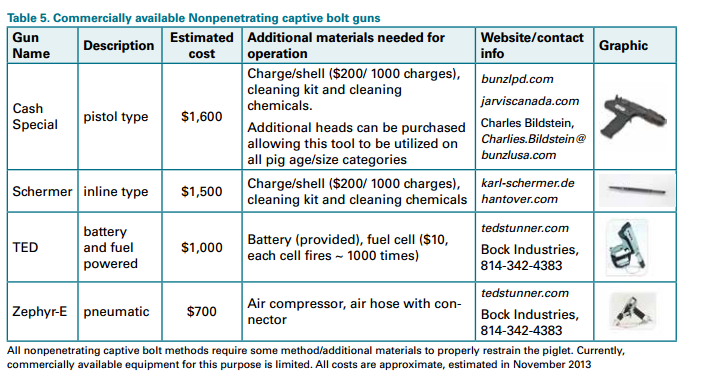



Alternative Euthanasia Methods to Manually Applied Blunt Force Trauma for Piglets
Gas euthanasia, non-penetrating captive bolt and other methods of euthanising for pigs weighing up to 12 pounds are explained an compared by Larry J. Sadler, Anna K. Johnson and Suzanne T. Millman of Iowa State University in a factsheet for Pork Information Gateway.Introduction
The most predominant method in the US for euthanasia of non-viable piglets (less than 12lbs.) is manually applied blunt force trauma (Ma-BFT). Manually applied blunt force trauma is one of several euthanasia techniques considered acceptable or conditionally acceptable by the American Veterinary Medical Association (AVMA, 2013).
However, Ma-BFT is being criticised on the basis of aesthetics, impacts on those performing the procedure, and ability to produce humane euthanasia consistency. Alternative methodologies to Ma-BFT will be discussed in this fact sheet, highlighting benefits and challenges of these methods, along with implementation techniques.
Objective
To provide guidance for producers seeking alternative methods to manually applied blunt force trauma for piglets weighing up to 12lbs (5.44kg).
Background
Swine producers, veterinarians and animal scientists, among others, generally agree that euthanasia is the best choice for low viability piglets, especially when there is suffering due to injury or illness. The USDA estimates around 120 million piglets are born yearly in the United States1. The average sow gives birth to about 12 live piglets per litter, but weans 102. Thus, an estimated 20 million piglets do not survive to weaning yearly in the US. More than half of these deaths occur in the first three days after birth due to causes such as crushing by the sow or are euthanized by caregivers3.
Low-viability piglets may be afflicted with physiological ailments, deformities or are underdeveloped. Additionally, despite being provided optimal care some piglets will become ill or injured, and in turn, will have little prospect of recovery.
Piglets that fall into these aforementioned categories are likely to experience suffering, thus becoming candidates for euthanasia.The term euthanasia is derived from the Greek language meaning 'good death', and defined by the Merriam-Webster Dictionary as 'the act or practice of killing or permitting the death of hopelessly sick or injured individuals in a relatively painless way for reasons of mercy'4. Similarly, euthanasia is described by the AVMA as 'ending of life of an individual animal in a way that minimises or eliminates pain and distress'5.
Death should be achieved through rapid loss of consciousness, and then cessation of cardiac and respiratory functions, followed by loss of brain function. The AVMA highlights several areas for assessing the acceptability of euthanasia methods, including:
- the ability to induce loss of consciousness and death without causing pain, distress, anxiety or apprehension
- time required to induce loss of consciousness
- reliability
- compatibility with species, age and health status, and
- emotional effect on observers or operators, and others.
Mechanically Applied Blunt force trauma is a ‘physical method’, with unconsciousness and death achieved through damage to the brain via concussive forces. There are several benefits to Ma-BFT, it can be conducted in a timely manner, thus ensuring piglet welfare, and it is inexpensive, making it a popular choice. However, in 2013, the AVMA noted that persons performing this method might become fatigued, which could lead to inconsistency in application creating humane concerns. The AVMA recommends producers currently utilizing Ma-BFT 'actively search for alternative approaches'5. Subsequently and in response to undercover videos highlighting Ma-BFT, several purchasers and suppliers of pork required producers to eliminate this practice6-8. Because of these factors, many producers are seeking advice on alternative methods of euthanasia for this piglet weight class.
Alternative 1: Gas Euthanasia
Gas euthanasia is approved by both the AVMA and NPB for all age and size categories of pigs; however, due to implementation issues, on farms it is often not practical to apply gas euthanasia to pigs past the nursery phase. Loss of consciousness and death result from a decrease in the pH of the body or from a lack of oxygen. Although carbon dioxide appears aversive to piglets during the brief period before unconsciousness occurs, escape attempts are rare. Caregivers may hear noises coming from the box, and these noises typically result from the normal involuntary movements that occur after the pig has become unconscious, no longer in control of its limbs, and no longer able to feel pain.
It is important to recognise these movements are normal and not likely to be an indicator of piglet distress or pain if gas concentrations are maintained according to the protocol. Post application, death should be confirmed via cardiac and respiratory arrest. Those conducting the procedure should be familiar with expected behavioural indicators of the procedure, allowing intervention if it falls outside of expected values (Table 1).
As with all methods, death should be confirmed ensuring application was successful. With gas, death should be confirmed approximately 15 minutes after first exposure to the gas. If implemented incorrectly, gas euthanasia has the potential to be highly aversive and painful to the piglet, thus it is critical that all procedures be followed to minimize pain and distress. To achieve the goal of minimal distress, there are a few required components: a sturdy, comfortable box, a gas regulator and a flow meter capable of producing the gas volume required.
Gas type: Carbon dioxide (CO2) is identified as an acceptable inhalant method of euthanasia for piglets on the basis that it is a rapid depressant with established analgesic and anesthetic properties10. Carbon dioxide gas can be purchased through many local welding or brewery suppliers. Carbon dioxide is mildly acidic and may irritate the mucus membranes of mammals. Some humans exposed to high concentrations of carbon dioxide report it to be painful and unpleasant, causing a sense of breathlessness11, thus following identified best practices is critical to ensure distress is minimised when using this gas.
Refinements to these procedures using carbon dioxide or alternative gases such as argon and nitrogen are being explored. The procedures below represent the best practices based on current research.
Flow rate: The current AVMA guidelines for pigs recommend utilising a prefill or slow flow rate (10 to 30 per cent box exchange rate)5. However, current research has yet to identify carbon dioxide concentrations that are not associated with aversive behavioral responses of piglets. Furthermore, a pre-filled environment is difficult to create with existing on-farm euthanasia equipment12. Hence, piglet welfare is likely better at faster flow rates (50 per cent box volume exchange rate) that balance duration of exposure and intensity of response. Flow meters and gas regulators are necessary components to ensure reliable gas flow rates. This equipment can be purchased from local welding suppliers or found online.
Because of the volume of gas utilized and the properties of carbon dioxide, freezing of the flow meter is a common problem, hence, a heated flow meter or a regulator is advised. Often heated flow meters and gas regulator combinations can be purchased for $200 to $600.
Examples of flow meter can be found on the following web site, www.arc-zone.com. Since high volume flow meters are typically capable of flow rates up to 125 cubic feet per hour, a single flow meter will produce a 50 per cent box volume exchange rate for a four cubic feet box (2’×2’× 1’). If a larger box is desired, more than one flow meter can be fitted to the box.
Hoses adequate for the pressure and temperature extremes produced by carbon dioxide can be purchased from the supplier of the flow meter. The inlet and exhaust ports should be placed near the top of the box reducing the potential of a pig or debris blocking the ports (Figure 1). Carbon dioxide gas is heavier than air, thus even when inlets are placed at the top, the box will still fill from bottom to top. Exhaust hoses should vent to the outdoors.
Box: The box should be of adequate size to allow the piglet to stand comfortably and turn around (Table 2). The authors recommend floor space guidelines consistent with pig transportation (Table 3). The box should allow the piglets adequate headroom to make head thrusts without hitting their head on the top of the box.
Research indicates that stocking density within the box has minimal effect on piglet responses to gas euthanasia13. However, piglets euthanised singly displayed behaviour consistent with isolation distress. The box should be free of pinch and protruding points that may cause pain. During the gas euthanasia process, piglets will produce strong involuntary movements (very strong clonic convulsions) thus it is critical that the box is sturdy and capable of withstanding this force. If the box becomes cracked or damaged, maintaining a gas concentration may become difficult.
Additionally, this damage may create pinch points causing pain. The price of the box will be the largest variable when costing the system, depending on material and size. If biosecurity is not a concern, one could be constructed with minimal expense utilising plywood and caulking to ensure no gas leaks. However, more robust and cleanable boxes can be purchased from many suppliers. The flooring should be non-slip. This can easily be achieved by placing a rubber truck mat cut to the size of the box’s floor. This mat will also aid in cleaning and sanitising of the box.
Temperature: Research indicates temperature within the box is minimally affected when utilising a flow rate up to a 50 per cent box volume exchange rate14. Consideration should be given to the location of the box, ensuring thermal neutral temperatures are provided during the process.
Carbon dioxide gas is very cold if “dumped” into the box at an uncontrolled flow rate, which is likely to create an aversive temperate that is distressing to the piglet.
Lighting: It is currently unknown if the piglet would prefer a dark or lighted environment during the gas euthanasia process. However, it is recommended the box be sufficiently lit with an observation window to allow the process to be monitored. Those performing the procedure have the ability to ensure that the process is running within expected outcomes. In the absence of a window caregivers must open the lid resulting in atmospheric air entering the box which displaces the carbon dioxide15.
Benefits: A benefit of gas euthanasia, in relation to piglet welfare, is that a relatively low level of restraint is required and being placed in a box allows the piglets to maintain normal behaviors and postures.
Another welfare benefit is the high efficacy (100 per cent) with minimal distress when proper procedures are followed; additionally, if deviations do occur, the piglet is often anesthetised allowing time to implement corrective action.
In relation to human factors, though euthanasia is never easy, many caregivers find this method less mentally fatiguing than the physical methods; this may aid in timely euthanasia decisions, with caregivers more willing to euthanise. Human safety concerns are minimal with this method if conducted in a properly ventilated location.
Challenges: The gas euthanasia process can be difficult for several reasons. First, the piglet will take longer to lose consciousness than with physical methods, which can be distressing for caregivers performing the procedure. Second, gas euthanasia systems are difficult to transport due to their size. If using stationary systems, piglets will likely need to be transported to the unit. It is important that caregivers recognize that the potential inconvenience of this distance is not a reason to delay euthanasia; procedures should be developed that ensure timely euthanasia regardless of system implemented.
Costs: Currently there is a single supplier for a piglet purpose designed gas euthanasia device (Figure 2), which is distributed by V-ast (Mason City, Iowa). Two box size options are available for $2,950 and $3,250 (priced in 2013).
Gas euthanasia is the only listed euthanasia option that allows producers to create their own system, potentially reducing initial investment costs. Construction of the gas euthanasia system will vary in cost, ranging from less than $300 to over $1,000. To operate the system, carbon dioxide will need to be purchased. The cost of operating the box on a per piglet basis will vary depending on the size of the box (Figures 3 and 4) and operational procedures. In general, cost per piglet will be less than $0.10.
Alternative 2: Non-penetrating Captive Bolt
Similar to Ma-BFT, non-penetrating captive bolt is a ‘physical method’ and is approved by both the AVMA and NPB for piglets up to 12lbs. Non-penetrating captive bolt devices are powered by cartridges (Cash Special, Schermer), pneumatic (Zephyr-E), or battery/fuel (TED). Loss of consciousness and death occur as a result of concussive forces; however, unlike Ma-BFT the non-penetrating captive bolt allows for greater caregiver control and decreased fatigue. The target site on the piglet for placement of a non-penetrating captive bolt is indicated in Figure 5.
The non-penetrating captive bolt must be placed flush and firmly against the piglet’s skull. Restraint of the pig is an important consideration and critical to proper application. Loss of consciousness should be nearly instant upon application. The piglet should be monitored for return to consciousness until death is confirmed via cessation of respiratory and cardiac function.
Anything other than immediate loss of consciousness should be considered a major failure, as this will result in painful physical damage and requires a planned corrective action be immediately applied. This corrective action could include a second shot. Those conducting the procedure should be familiar with expected behavioral indicators of the procedure, allowing intervention if it falls outside of expected values (Table 4).
Benefits: Non-penetrating captive bolts are portable, fast in their application and result in instantaneous loss of consciousness. Some caregivers prefer this instantaneous loss of unconsciousness that is not created with gas euthanasia.
Challenges: Immobilisation of the piglet is required and after successful application piglets display intense involuntary movements (paddling) that can be aesthetically displeasing. Caregivers may find this physical act emotionally challenging to perform.
This method also presents an increased safety hazards to caregivers due to the close proximity between site of application and restraining area inherent with a small pig. While research indicates very high efficacy (100 per cent,14), based on the author’s experience with this methodology, even when following procedures with care, a small number of piglets may require a corrective step to ensure a humane death. This corrective step may include a second application of the non-penetrating captive bolt. Lack of maintenance and improper storing of equipment may lead to poor performance. This equipment requires frequent maintenance, cleaning, and low humidity storage to ensure proper function.
Commercially available non-penetrating captive bolt equipment
Several new products have come on the market (Table 5). All products have undergone manufacture and third party testing using the pig as a model. These products are highly reliable and effective. However, the cost of these products may make them prohibitive for some producers. Apart from snares, the authors are unaware of any commercially available equipment that is commonly used by producers for restraining piglets. However, some producers have created their own devices, such as a modified PVC pipe (Figure 6).
Penetrating Captive Bolt, Gunshot and Electrocution
While recognised as a humane and effective method for euthanasia of pigs, penetrating captive bolt and gunshot are not identified as acceptable for piglets 12lbs. or less in the AVMA or NPB guidelines.
The exclusion of these methods for this size of piglet is unclear. Because electrocution does not reliably result in death of small animals, this method is not approved by the AVMA for animals less than 11lbs. Similarly, NPB does not approve electrocution for piglets less than 10lbs.14
Summary
Currently, there are several viable options to replace Ma-BFT, however, these all involve a relatively high initial investment.
In general, producers are left with two viable options, gas euthanasia and non-penetrating captive bolt.
Recognising effectiveness of the method for inducing euthanasia with the least piglet suffering is of highest importance and researchers continue to examine this issue.
In addition to cost and animal welfare, decisions about alternatives to Ma-BFT should consider effects on caregivers and implications for timely euthanasia decision-making.
Literature Cited
- United States Department of Agriculture, National Agricultural Statistics Services. 2010. Quarterly Hogs and Pigs.
- USDA. United State Department of Agriculture, National Animal Health Monitoring System. 2008. Highlights of Swine 2006 Part III: Reference of Swine Health, Productivity, and General Management in the United States.
- Alonso-Spilsbury, M., Ramírez-Necoechea R., González-Lozano M., Mota-Rojas D. and Trujillo-Ortega M. 2007. Piglet survival in early lactation: a review. J. Anim. Vet. Advan. 6:76-86.
- Merriam-Webster. Euthanasia. Merriam-Webster.
- AVMA. American Veterinary Medical Association. 2013. Guidelines for the euthanasia of animals: 2013 edition. Schaumburg, Illinois.
- Tyson Foods. 2014. Tyson Foods Letter to Hog Farmers.
- AVMA. American Veterinary Medical Association. 2012. Hot on Facebook: Euthanasia of Suckling Pigs Using Blunt Force Trauma.
- PorkNetwork.com. 2013. AVMA recommends alternative to blunt force trauma.
- Sadler, L. and Millman, S. 2012. Advances in Gas Euthanasia Techniques and Equipment. Proceedings from the Swine Disease Conference for Swine Practitioners. Ames, IA. p94-98.
- AVMA. American Veterinary Medical Association. 2007. Guidelines on euthanasia, formerly report of the AVMA panel on euthanasia. Schaumber, IL, USA.
- Gregory, N., Mohan-Raj A., Audsey A., and Daly C. 1990. Effects of CO2 on man. The use of CO2 for stunning of slaughter pigs, Fleischwirtschaft 70:7-9.
- Sadler, L.J., Karriker, L.A., Johnson, A.K., Schwartz, K.J., Widowski, T.M., Wang, C. and Millman, S.T. 2014. Swine respiratory disease minimally affects responses of nursery pigs to gas euthanasia. J. Swine Health Prod. 22:125-133.
- Fiedler, K.J., Sadler, L.J., Parsons, R. L. and Millman, S.T., Accepted. Effects of stocking rate on measures of efficacy and welfare during carbon dioxide gas euthanasia of young pigs. Anim. Welf.
- Sadler L.J., Hagen C.D., Wang C., Widowski, T.M., Johnson A.K and Millman S.T. 2014. Effects of flow rate and gas mixture on the welfare of weaned and neonate pigs during gas euthanasia. J. Anim. Sci. 92:793-805.
- Sadler, L..J., Karriker, L.A., Schwartz, K.J., Johnson, A.K., Widowski, T.M., Wang, C., Sutherland, M.A. and Millman, S.T. 2014. Are severely depressed suckling pigs resistant to gas euthanasia? Anim. Welf. 23:145-155.
- Casey-Trott, T.M., Millman, S.T., Turner, P.V., Nykamp, S.G. and Widowski, T.M. 2013. Effectiveness of a nonpenetrating captive bolt for euthanasia of piglets less than 3d of age. J. Anim. Sci. 91:5477-5484.
Frequently Asked Questions
Q. When using gas euthanasia, are all sounds heard from the box indications of escape and distress by the piglet?
A. Caregivers may hear noises coming from the box, and these noises typically result from the normal involuntary movements that occur after the pig has become unconscious, no longer in control of its limbs, and no longer able to feel pain. It is important to recognise these movements are normal and not likely to be an indicator of piglet distress or pain if gas concentrations are maintained according to the protocol.
Q. Is one of the benefits to gas euthanasia the elimination of the need to check for sensibility and death post procedure?
A. As with all methods, death should be confirmed ensuring application was successful.
Q. How long after initiating gas euthanasia should I wait before confirming death?
A. Death should be confirmed approximately 15 minutes after first exposure to the gas.
Q. Where can carbon dioxide be purchased?
A. Carbon dioxide gas can be purchased through many local welding or brewery suppliers.
Q. What flow rate is currently recommended for piglet euthanasia?
A. Piglet welfare is likely better at faster flow rates (50 per cent box volume exchange rate) that balance duration of exposure and intensity of response.
Q. What is the target site when using a non-penetrating captive bolt?
A. The target site on the piglet for placement of a non-penetrating captive bolt is shown in Figure 5 above.
Q. After application of the non-penetrating captive bolt, when should you check for sensibility?
A. Immediately or as soon as it is safe to verify.
December 2014







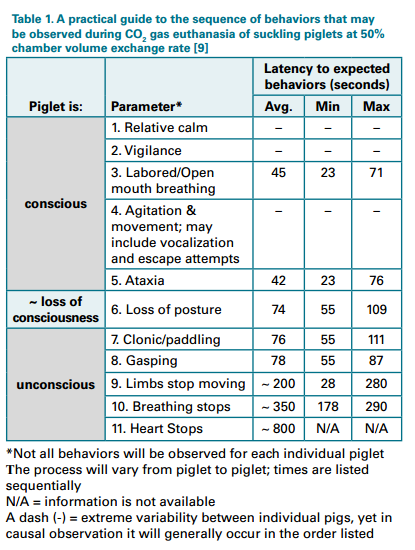
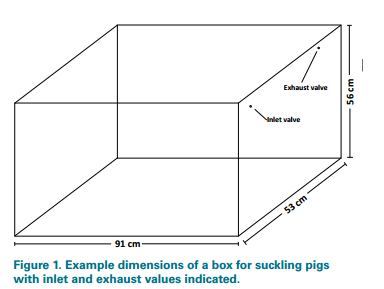
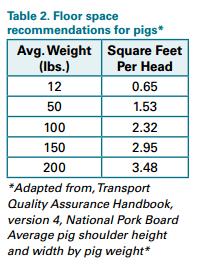
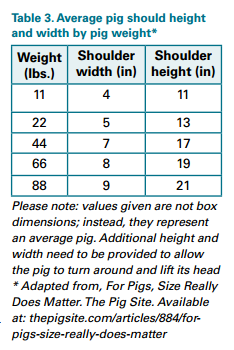
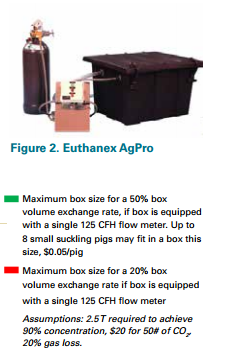
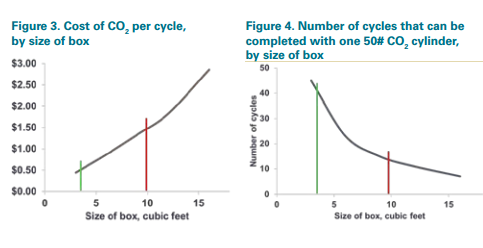
.PNG)
